Pears
Often planted with apples but require a more sheltered, sunnier spot. They also flower earlier than apples and so are more at risk of late frosts so avoid frost pockets if possible. Some pears are partially self fertile, Conference being the most common, but all varieties crop better if another pear is planted nearby for pollination.
All are eating varieties except for Catillac. Many varieties are very old- the word "new" means in the last hundred years for pears! Picking time can start in mid August (as for Jargonelle), but most are around early October.
Of the reliable varieties grown in gardens nowadays, hardly any will store past Christmas. Most can be trained into any shape-Cordon, Fan and Espalier. Except for Jargonelle, all are still hard when ready for picking (A lift and slight twist) and only develop their full flavour and softness when stored in the fruit bowl for a few days. Descriptions and drawbacks mentioned are for trees grown in the open. Fruit size and quality increase an awful lot when grown against a sunny south or west wall.
Choice of Rootstocks
Pears have limited rootstocks compared to apples, Quince C or Quince A. C being slightly smaller.
With pears, formative and subsequent pruning is more important than what rootstock they're on.
QUINCE C SEMI-DWARF
For more compact trained trees or larger bushes
QUINCE A SEMI-VIGOROUS
For larger trained and free standing trees
VARIETIES GROWN IN THE TRIALS GARDEN
Beth
A new variety with good all-round garden performance. Small, smooth skinned fruit and sweet, juicy flesh. Reliable cropper (Kent 1938)
RHS Award of Garden Merit 1993
Beurre Hardy
Great flavour and has some scab resistance which is useful in wet summers and, like many pears, puts on a good show of autumn colours. Picks end of August
RHS Award of Garden Merit 1993
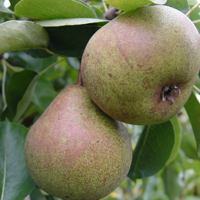
Catillac
The only cooking pear grown here as the usual advice for cooking is to pick an eating variety early. However this had perfect fruit every year and big, like 400 watt light bulbs! Only for cooking (excellent stewed) (France 1665)
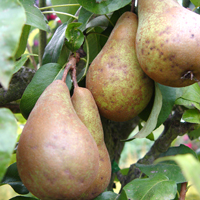
Concorde
A modern variety, self-fertile and a good pollinator for Doyenne du Comice. Heavy cropping. Large fruit and compact growth. Pale flesh which is sweet and juicy. (Kent 1977)
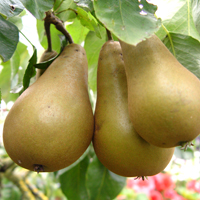
Conference
Another self fertile variety like Concorde with medium sized, yellowish green fruit with some russeting and excellent flavour. A good cropper and suitable for all areas of the UK (Herts. 19th century)
Doyenne du Comice
Superb quality fruit having a juicy, rich flavour. Needs good pollination to get a crop-plant Conference or Williams nearby (France, 19th century). Best in warm, sunny spot.
Jargonelle
The earliest to crop in this garden-around mid August. Pick as soon as ready or they all end up on the floor as I've found to my cost!. Best eaten straight off the tree or within a couple of days of picking. Excellent flavour and reliable. Tendency to bear some of its fruit on the tips of branches so best grown as a free standing bush although it does well here as a cordon with regular summer pruning. Hardy, long lived and trouble free (c.1629)
Louise bon of Jersey
Not a large pear but excellent flavour, sweet with melting flesh. Attractive dark red flush on the sunny side. A reliable cropper of good quality (France 1780)
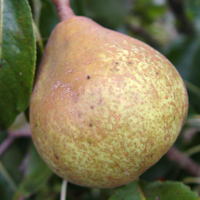
Onward
One of the "new" pears with a reputation for good garden performance and always seems to do well here. Medium size fruit with a pink blush or occasional russeting. Sweet, rich and juicy flavour. For reasons known only to itself, will not pollinate Doyenne du Comice! (Surrey 1947).
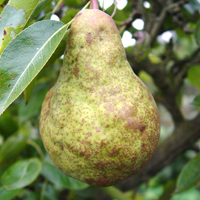
Packham's Triumph
Medium to large fruit that will need thinning if it sets a heavy crop. The pear usually found in tins. Pale flesh is sweet and juicy with a musky flavour. A compact, tidy tree that crops well and stores well in to December (Australia 19th century)
Can crop without pollination but you will have lumpy looking but perfectly edible fruit
Williams bon Chrétien
or just Williams as it is also known
Large pale green turning to golden yellow fruit . Fine flavoured and sweet. A regular cropper but susceptible to scab problems on the foliage and, in bad years, the fruit as well (Aldermaston 18th century.)
Invincible
A new tough and hardy pear, setting fruit regularly in less than ideal circumstances. Yet to be planted here in the garden. Fruit quality is said to be only fair, its main strengths are its yields and regular cropping. A good pollinator for other varieties. Self Fertile. Can also be used for cooking and preserving.
